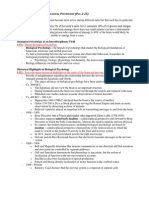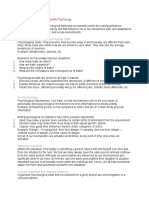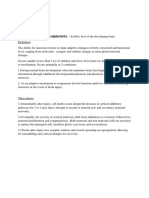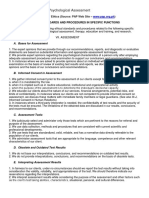Chapter 1 Notes
Uploaded by
Katarina GruborovićCopyright:
Available Formats
Chapter 1 Notes
Uploaded by
Katarina GruborovićCopyright
Available Formats
Share this document
Did you find this document useful?
Is this content inappropriate?
Copyright:
Available Formats
Chapter 1 Notes
Uploaded by
Katarina GruborovićCopyright:
Available Formats
Chapter 1: Biopsychology as a
NeuroscienceWhat is
Biopsychology, Anyway?
NeuronsCells that receive and transmit electrochemical signals.
Neurosciencethe scientific study of the nervous system.
Comprises of several related disciplines.
What is Biopsychology?
BiopsychologyThe scientific study of the biology of behaviour. Some refer
to this as psychobiology, behavioural biology, or behavioural neuroscience.
Biopsychology did not develop into a discipline until the 20th century.
What Is the Relation between Biopsychology and other
Disciplines in Neuroscience?
Biopsychologists are neuroscientists who bring to their research a
knowledge of behaviour and of the methods of behavioural research.
Disciplines relevant to biopsychology:
NeuroanatomyThe study of the structure of the nervous system.
NeurochemistryThe study of the chemical bases of neural activity.
NeuroendocrinologyThe study of interactions between the nervous
system and the endocrine system.
NeuropathologyThe study of nervous system disorders.
NeuropharmacologyThe study of the effects of drugs on neural
activity.
NeurophysiologyThe study of the functions and activities of the
nervous system.
What Type of Research Characterize the Biopsychological
Approach?
Biopsychological research can involve human or non human subjects.
Human and Nonhuman Subjects
Rats are the most common, however mice, cats, dogs and non-human
pimates are also studied.
Human subjects are the most convenient in biopsychology and the
least costly.
The brains of humans differ from other mammals, so studying on the
brain of a human has the most advantages.
Nonhuman subjects have three advantages over human subjects:
1. The brain and the behaviour of nonhuman subjects are simpler
that those of human subjects. Therefore the study of nonhuman
secies is more likely to reveal fundamental brain-behaviour
interactions.
2. insights frequently arise from the comparative approach, the
study of biological processes by comparing different species. For
example, comparing the behavior of species that do not have a
cerebral cortex with the behavioros species that do can provide
valuable clues about cortical function.
3. Possible to conduct experiments on animals that is not ethical to
conduct on humans.
Experiments and Nonexperiments
Experiments
Used by scientists to find causation.
The experimenter sets two conditions under which the subjects will be
tested. Ususally, a different group of subject is tested under each
condition (between-subject design), but sometimes it is possible to
test the same group of subjects under each conditions (withinsubject design).
Difference between conditions is called the independent variable.
The variable that is measured by the experimenter to asses the effects
of the independent variable is called the dependant variable.
A variable that might have an effect on the dependant variable that
differs from the independent variable is called the confounding
variable.
Coolidge Effect is the fact that a copulating male who becomes
incapable of continuing to capulate with one sex partner can often
recommence copulating with a new sex partner (created by Lester and
Gorzalka).
Lordosis is when a mammal has an arched-back, rump-up, taildevirted posture (female when she is ready to have sex).
Quasiexperimental Studies
Quasiexperimental studies are studies on groups of subjects who
have been exposed to the conditions of interest in the real world.
These seem like experiments, however theyre not because their
confounding variables have not been controlled for.
Case Studies
Studies that focus on a single case or subject are called case studies.
Because they focus on a single case, they usually provide more in
depth information. However, they have a problem with their
generalizability.
Generalizability is the degree to which results can be applied to
other cases.
Pure and Applied Research
Pure research is research motivated primarily by the curiosity of the
researcher. It is done solely for the purpose of acquiring knowledge.
Applied research is research intended to bring about some direct
benefit to humankind.
Pure research is more vulnerable to the vagaries of political regulation
because politicians and the voting public have difficulties
understanding why research of no immediate practical benefit should
be supported.
What Are the Divisions of Biopsychology?
Psychological Psychology
This is the division of biopsychology that studies the natural
mechanisms of behaviour throughout direct manipulation of the brain
in controlled experimentssurgical or electrical manipulations are the
most common.
Usually laboratory animals.
Psychopharmacology
This is similar to psychological psychology, except that it focuses on
the manipulation of neural activity and behaviour with drugs.
Although drugs are sometimes used by psychopharmacological to
study the basic principles of brain-behaviour interaction, the purpose
of many psychopharmacological experiments is to develop therapeutic
drugs, and to reduce drug abuse.
Neuropsychology
This is the study of psychological effects of the brain damage in human
patients.
This deals exclusively with case studies and quasiexperimental studies
of patients with brain damage resulting from disease, accident, or
neurosurgery.
The cerebral cortex is the most likely to be damaged from an accident
or surgery.
This is the most applied field in the discipline.
Psychophysiology
This is a division of biopsychology that studies the relation between
physiological activity and psychological processes in human subjects.
This discipline usually uses an EEG.
Some other measures are muscle tension, eye movement, and several
indicators of autonomic nervous system activity.
The autonomic nervous system (ANS) is the division of the
nervous system that regulates the bodys inner environment.
Cognitive Neuroscience
This is the youngest division of biopsychology, but it is currently among
the most active and exciting.
Cognitive neuroscientists study the neural bases of cognition, a term
that generally refers to higher intellectual processes such as thought,
memory, attention, and complex perceptual processes.
Methods for this field are non-invasive as researchers work on human
subjects.
The biggest method of cognitive neuroscience is functional brain
imaging while a subject is engaged in a particular cognitive activity.
Comparative Psychology
Comparative psychologists compare the behaviour of different species
in order to understand the evolution, genetics, and adaptions of
behaviour.
Some psychologists engage in ethological research, which is the
study of animal behaviour in its natural environment.
Evolutionary psychology and behavioural genetics are a part of
comparative psychology.
Covering Operations: How Do Biopsychologists Work
Together?
A combined approach is called converging operations. Progress is
most likely made when different approaches are focused on on a single
problem in such a way that the strength of one approach compensates
for the weaknesses of the others.
Korsakoffs syndrome is when one has severe memory loss, and
because this occurs commonly in alcoholics, it was initially believed to
be a direct consequence of the toxic effect of alcohol in the brain.
Scientific Inference: How Do Biopsychologists Study the
Unobservable Workings of the Brain??
Scientific inference is when scietists measure key events that they
can observe and then use these measures as a basis for logically
inferring the nature of events that they can not observe.
Critical Thinking about Biopsychological Claims
Critical thinking is spotting a weakness of existing ideas and the
evidence on which they are based.
The first step to determine if something is valid is by judging the
validity of the research publications and if it is a reputable scientific
journal. The journal must go through a review process, and if it has not,
you should be skeptical about the information provided.
You might also like
- Bio 345 Evolution Activity 1-1 - Natural - Selection ASUNo ratings yetBio 345 Evolution Activity 1-1 - Natural - Selection ASU8 pages
- Lesson 1. Overview of Physiological PsychologyNo ratings yetLesson 1. Overview of Physiological Psychology8 pages
- Schaffeld AP Psychology Review Worksheet Famous Psychologists100% (4)Schaffeld AP Psychology Review Worksheet Famous Psychologists6 pages
- Physiological Psychology Lecture Notes: Nervous System DamageNo ratings yetPhysiological Psychology Lecture Notes: Nervous System Damage3 pages
- Chapter 1 Textbook Notes - Introducing Biological Psychology100% (1)Chapter 1 Textbook Notes - Introducing Biological Psychology7 pages
- L1 - Introduction To Clinical NeuropsychologyNo ratings yetL1 - Introduction To Clinical Neuropsychology11 pages
- Biological Perspective On Personality: Course: Personality Theories (Psy 711) Lecturer: DR AyodejiNo ratings yetBiological Perspective On Personality: Course: Personality Theories (Psy 711) Lecturer: DR Ayodeji24 pages
- What Are The Parts of The Brain and Their FunctionsNo ratings yetWhat Are The Parts of The Brain and Their Functions2 pages
- Reaction Paper For Man's Search For MeaningNo ratings yetReaction Paper For Man's Search For Meaning2 pages
- Experimental Psychology Finals Reviewer (Myers Hansen)No ratings yetExperimental Psychology Finals Reviewer (Myers Hansen)17 pages
- Module - Wk5&6 - The Biological Foundation of BehaviorNo ratings yetModule - Wk5&6 - The Biological Foundation of Behavior11 pages
- Experimental Psychology Notes: by DanigürlNo ratings yetExperimental Psychology Notes: by Danigürl7 pages
- Experimental Psychology Chapter 6-9 Notes (Myers Hansen)No ratings yetExperimental Psychology Chapter 6-9 Notes (Myers Hansen)10 pages
- History of Philippine Psychology - Filipino PsychologyNo ratings yetHistory of Philippine Psychology - Filipino Psychology3 pages
- Chapter 3: Visual Perception: Cognitive PsychologyNo ratings yetChapter 3: Visual Perception: Cognitive Psychology4 pages
- Perspective in Theories of Personality: o Maslow o RogersNo ratings yetPerspective in Theories of Personality: o Maslow o Rogers19 pages
- INTROPSY Reviewer (Book-Based Only) Chapters 1-2No ratings yetINTROPSY Reviewer (Book-Based Only) Chapters 1-212 pages
- Historical Background of Social Psychology100% (1)Historical Background of Social Psychology91 pages
- Introduction To Psychology: Topic OutlineNo ratings yetIntroduction To Psychology: Topic Outline23 pages
- 13 Motor Control and Reflexes Edit NOquesNo ratings yet13 Motor Control and Reflexes Edit NOques22 pages
- The Referral Question - Purpose of Assessment by Setting or Context100% (1)The Referral Question - Purpose of Assessment by Setting or Context3 pages
- Research Methods in Cognitive PsychologyNo ratings yetResearch Methods in Cognitive Psychology3 pages
- Reviewer in TOP (CARL JUNG'S ANALYTICAL PSYCHOANALYSIS)No ratings yetReviewer in TOP (CARL JUNG'S ANALYTICAL PSYCHOANALYSIS)11 pages
- Ethical Considerations in Psychological AssessmentNo ratings yetEthical Considerations in Psychological Assessment5 pages
- Biodiversity: Science, Technology and Society (Gec 130)No ratings yetBiodiversity: Science, Technology and Society (Gec 130)18 pages
- Additional Chapter 5 Self-Assessment Exercises: Matching QuestionsNo ratings yetAdditional Chapter 5 Self-Assessment Exercises: Matching Questions11 pages
- The Human Body and Homeostasis Pre-TestNo ratings yetThe Human Body and Homeostasis Pre-Test13 pages
- TP53 TP53 TP53 TP53: Therapy Tested Marker Predicted ResponseNo ratings yetTP53 TP53 TP53 TP53: Therapy Tested Marker Predicted Response11 pages
- The Sugar Oxidation Cascade: Aerial Refueling in Hummingbirds and Nectar BatsNo ratings yetThe Sugar Oxidation Cascade: Aerial Refueling in Hummingbirds and Nectar Bats7 pages
- (P. T. K. Woo) Fish Diseases and Disorders VolumeNo ratings yet(P. T. K. Woo) Fish Diseases and Disorders Volume10 pages
- Role of Environmental Monitoring - Manufacture of Sterile Drugs and Biologics - American Pharmaceutical ReviewNo ratings yetRole of Environmental Monitoring - Manufacture of Sterile Drugs and Biologics - American Pharmaceutical Review14 pages
- Bio 345 Evolution Activity 1-1 - Natural - Selection ASUBio 345 Evolution Activity 1-1 - Natural - Selection ASU
- Schaffeld AP Psychology Review Worksheet Famous PsychologistsSchaffeld AP Psychology Review Worksheet Famous Psychologists
- Physiological Psychology Lecture Notes: Nervous System DamagePhysiological Psychology Lecture Notes: Nervous System Damage
- Chapter 1 Textbook Notes - Introducing Biological PsychologyChapter 1 Textbook Notes - Introducing Biological Psychology
- Biological Perspective On Personality: Course: Personality Theories (Psy 711) Lecturer: DR AyodejiBiological Perspective On Personality: Course: Personality Theories (Psy 711) Lecturer: DR Ayodeji
- What Are The Parts of The Brain and Their FunctionsWhat Are The Parts of The Brain and Their Functions
- Experimental Psychology Finals Reviewer (Myers Hansen)Experimental Psychology Finals Reviewer (Myers Hansen)
- Module - Wk5&6 - The Biological Foundation of BehaviorModule - Wk5&6 - The Biological Foundation of Behavior
- Experimental Psychology Chapter 6-9 Notes (Myers Hansen)Experimental Psychology Chapter 6-9 Notes (Myers Hansen)
- History of Philippine Psychology - Filipino PsychologyHistory of Philippine Psychology - Filipino Psychology
- Chapter 3: Visual Perception: Cognitive PsychologyChapter 3: Visual Perception: Cognitive Psychology
- Perspective in Theories of Personality: o Maslow o RogersPerspective in Theories of Personality: o Maslow o Rogers
- The Referral Question - Purpose of Assessment by Setting or ContextThe Referral Question - Purpose of Assessment by Setting or Context
- Reviewer in TOP (CARL JUNG'S ANALYTICAL PSYCHOANALYSIS)Reviewer in TOP (CARL JUNG'S ANALYTICAL PSYCHOANALYSIS)
- Ethical Considerations in Psychological AssessmentEthical Considerations in Psychological Assessment
- Biodiversity: Science, Technology and Society (Gec 130)Biodiversity: Science, Technology and Society (Gec 130)
- Additional Chapter 5 Self-Assessment Exercises: Matching QuestionsAdditional Chapter 5 Self-Assessment Exercises: Matching Questions
- TP53 TP53 TP53 TP53: Therapy Tested Marker Predicted ResponseTP53 TP53 TP53 TP53: Therapy Tested Marker Predicted Response
- The Sugar Oxidation Cascade: Aerial Refueling in Hummingbirds and Nectar BatsThe Sugar Oxidation Cascade: Aerial Refueling in Hummingbirds and Nectar Bats
- Role of Environmental Monitoring - Manufacture of Sterile Drugs and Biologics - American Pharmaceutical ReviewRole of Environmental Monitoring - Manufacture of Sterile Drugs and Biologics - American Pharmaceutical Review

























































































